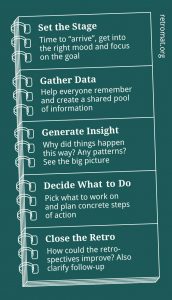[There’s a German version of this text.]
A retrospective is an opportunity to learn and improve. It is time set aside – outside of day-to-day routine – to reflect on past events and behaviors. In its simplest form you answer 3 questions:
- What worked well?
- What didn’t work well?
- What are we going to try to do differently?
In none-agile environments retrospectives are sometimes done after a project is finished as a “post mortem” to derive “lessons learned”. Those tend to be long meetings.
In constrast, in agile environments, a retrospective is short and done often (e.g. 90 minutes at the end of a 2-week sprint). Thus the project is still in progress and you can address issues jeopardizing the project’s success in time, hopefully keeping it on track.
In Scrum, retrospectives belong to the cast of regular sprint meetings. In Kanban there’s a variety of ways to “schedule” retrospectives. In Lean A3’s can serve the same purpose.
Who takes part?
“The team” whoever that includes in your context. In Scrum it’s usually the whole Scrum team with dev team, PO and SM. If you have a specific topic that includes / affects people from outside the team invite them to work on a joint solution.
What does a retrospective look like?
In its simplest form, a bunch of people
- meet
- talk about stuff and
- agree on some actions (that will hopefully improve the situation).
Usually retrospectives are a little more sophisticated than that. Most follow the 5 phases suggested in “Agile Retrospectives“:

- Set the stage
Set the goal; Give people time to “arrive” and get into the right mood - Gather data
Help everyone remember; Create a shared pool of information (everybody sees the world differently) - Generate insight
Why did things happen the way they did?; Identify patterns; See the big picture - Decide what to do
Pick a few issues to work on and create concrete action plans of how you’ll address them - Close the retrospective
Clarify follow-up; Appreciations; Clear end; How could the retrospectives improve?

You can support each phase with activities to spark ideas and interaction. Look at the Retr-O-Mat to see examples for such activities.
What is a retrospective NOT:
- A blame game – Retrospectives are not about ass coverage and assigning blame. In fact, some facilitators start their retrospectives by reading out the “Retrospective Prime Directive“:
Regardless of what we discover, we understand and truly believe that everyone did the best job they could, given what they knew at the time, their skills and abilities, the resources available, and the situation at hand.
Concentrate on what you will do in the future.
- Just another meeting in which talk is cheap but no change follows – If the retrospectives don’t produce concrete actions or if no one carries them out afterwards, retrospectives are a waste of time.
If you like the idea of retrospectives, Retromat can help you plan them and this 1-pager helps you teach others about retrospectives. Looking for ideas for your first retrospective? Try this plan.
